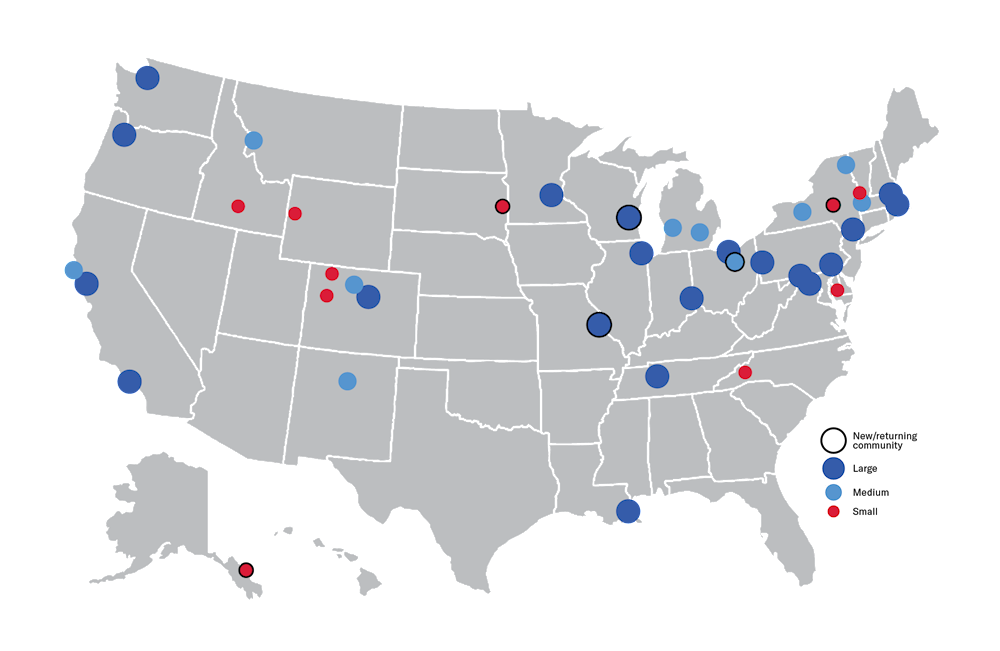The Top 40 Most Arts-Vibrant Communities of 2023
San Francisco-San Mateo-Redwood City, CA, reclaims top spot on the list of most arts-vibrant large communities for the first time since 2018; Milwaukee-Waukesha, WI and Canton-Massillon, OH secure rankings for the first time ever.

Executive Summary
SMU DataArts, the National Center for Arts Research, presents the 2023 Arts Vibrancy Index which recognizes and celebrates the most arts-vibrant communities across the United States. Programming shutdowns, layoffs, shifts in audience behavior, and financial uncertainties continue to underscore systemic inequities around arts access, funding, and arts employment, yet communities have found ways to endure and find resiliency through a collective appreciation of the arts.
When assessing a community’s vibrancy, we take a data-driven approach drawing on 13 unique measures which cover aspects of supply, demand, and public support for arts and culture, and are adjusted for cost of living and population.
In this year’s index, we’ve updated our analysis approach to weight these 13 inputs based on their relative explanatory power for the underlying concept of arts vibrancy. This approach allows us to improve our measurement consistency in the face of data availability delays or other changes in individual datasets from year to year. You can read more about this change in the methodology section.
In these rankings we highlight and celebrate communities big and small, located in every region, that have cultivated higher levels of arts activity per person living in the community. These communities sustain their vibrancy through various resources including public support and engagement, local arts agencies, convention and visitor bureaus, and other institutions committed to promoting cultural enrichment and fostering creative expression, ensuring that the arts remain an integral part of community life. In addition to the top Arts-Vibrant Communities listed in this report, Arts Vibrancy scores for every county in the United States can be viewed in an accompanying map to identify arts and cultural strengths that are present in every community.
While our approach to assessing Arts Vibrancy is robust, we readily acknowledge that there are other characteristics of vibrancy that are not possible to capture and assess evenly on a national scale for every community, especially tribal communities. We are continually evaluating new datasets for inclusion in our calculations in attempts to capture additional facets of vibrancy within communities. For now, we base the metrics in this report on the most reliable and geographically inclusive sources of data available.
Highlights from this Year's List
- Highly arts vibrant communities are dispersed broadly throughout the United States. Every region of the country has vibrant arts communities that appear in this report. This finding arises naturally out of objective analysis of the data, not from any selection of communities to achieve geographic representation. From Ohio to Colorado, New York to Alaska, Arts Vibrant communities recognize regional artistic diversity and community success.
- Two new communities made it into the top Arts Vibrant communities lists this year.
- Milwaukee-Waukesha, WI joined the list of large communities.
- Canton-Massillon, OH joined the list of medium communities
- After being absent from the top lists for over five years, Pittsburgh, PA, St. Louis, MO, and Juneau, AK returned, showcasing their arts vibrant communities.
- Ann Arbor, MI, Kalamazoo-Portage, MI, and Brevard, NC have returned to the list after their 2022 debut.
- Thirteen large communities have made the list every year since 2015, although their rankings have shifted over time.
- San Francisco-San Mateo-Redwood City, CA sits at the top of list for the first time since 2018.
- Philadelphia, PA moved into the top 5 for the first time.
- Cincinnati, OH-KY-IN after debuting in the 20th spot in 2020, has been able to maintain its place on the list and has moved to the 11th spot.
- Santa Fe, NM, San Rafael, CA, and Pittsfield, MA have appeared on the list of top medium communities every year since 2015.
- Jackson, WY-ID and Bennington, VT have made the list of small communities every year since 2015, with Jackson maintaining its ranking as first among small communities for the past four consecutive years.
Joining us for an engaging conversation are three remarkable arts leaders, representing two unique geographical regions, but all sharing an unwavering commitment to nurturing the arts in their communities.